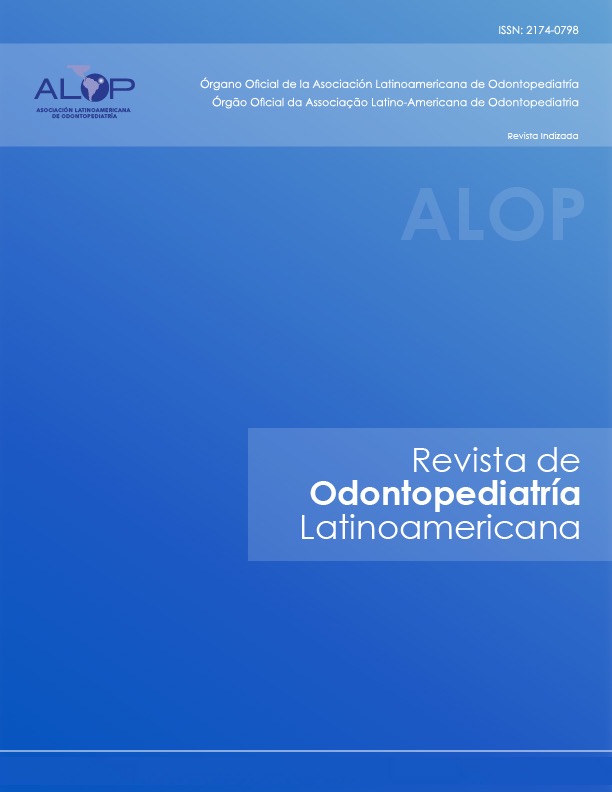Dentinogenesis imperfecta type II: Case Report
DOI:
https://doi.org/10.47990/alop.v3i2.46Keywords:
Dentinogenesis Imperfecta, childAbstract
Dentinogenesis Imperfecta is an autosomal dominant dental development anomaly that affects both the primary and permanent dentition.
The complications arising from Dentinogenesis Imperfecta are complex to treat and imply a great challenge to the dentist. That is why it is important to recognize the main characteristics of the disease so as to give the patient the best practice possible. A case is reported of an eightyear-old boy having a family history with similar expression of the disease. The child consulted for an esthetic reason, wanting to improve the appearance of his anterior teeth. It is described both clinical and radiographic diagnostic as well as the course of treatment and prognosis.
References
Beattie, M.L., Kim J.W, Gong S.G., et al. Phenotypic Variation in Dentinogenesis imperfecta/Dentin dysplasia Linked to 4q21. J Dent Res 2006; 85:329-333.
Wei, S.H. Pediatric dentistry: Oral patient care. 1st ed, Philadelphia: Le and Febiger; 1988.
Subramaniam P., Mathew S., Sugnani S.N. Dentinogenesis imperfecta: A case report. J Indian Soc Pedod Prevent Dent 2008:85-87.
Shields ED, Bixler D, el-Kafrawy AM. A proposed classification for heritable human dentin defects with a description of a new entity. Arch Oral Biol 1973;18: 543-553.
Rodriguez, E.A., Terés, G.M., San Martín, B.W., et al. Dentinogenesis Imperfecta Tipo II. Caso Clínico. Oral Año 5. Núm. 15 Primavera 2004. 224-226.
Witkop, CJ. Hereditary defects in enamel and dentin. Aeta Genet Stat Med 1957;7(1):236-9.
Delgado, A.C., Ruiz M., Alarcón, J.A., et al. Dentinogenesis imperfecta: The importance of early treatment. Quintessence Publishing Co; 2008:257-263.
Hodge, H.C., Finn, S.B., Robinson, H.B., et al. Hereditary Opalescent Dentin. J Dent Res 1940;19:521-536.
Takagi, Y., Koshiba, H., Kimura, O, et al. Dentinogenesis imperfecta: evidence of qualitive alteration in the organic dentin matrix. J Oral Path 1980; 9:201-209.
Reiskin, A. Dentinogenesis Imperfecta. Quintessence Publishing Co; 1981:617-622.
Koch Göran, Poulsen Sven. Pediatric Dentistry. A Clinical Approach. Second Edition. Blackwell Publishing Ltd, 2009.
McDonald Avery DR. Dentistry for the child and adolescent. 8th ed, St Louis: CV Mosby Co; 2004.
Wei SH. Pediatric dentistry: Oral patient care. 1st ed. Philadelphia: Le and Febiger; 1988.
Rios, D., Vieira, A.L.F., Tenuta, L.M.A., de Andrade Moreira Machado, M.A. Osteogenesis imperfecta and dentinogenesis imperfecta: Associated disorders. Quintessence Publishing Co; 2005:695-971.
DiAngelis, A. J., Andreasen, J. O., Ebeleseder, K. A., et al. (2012), International Association of Dental Traumatology guidelines for the management of traumatic dental injuries: 1. Fractures and luxations of permanent teeth. Dental Traumatology, 28: 2–12. doi: 10.1111/j.1600-9657.2011.01103.x
Shafer, W.C., Hine, M.K., Levy B.M, et al. A textbook of oral pathology. Philadelphia. WB Saunders Co; 1993:58-61
Downloads
Published
Issue
Section
License
Copyright (c) 2013 Latin American Pediatric Dentistry Journal

This work is licensed under a Creative Commons Attribution-NonCommercial-ShareAlike 4.0 International License.























